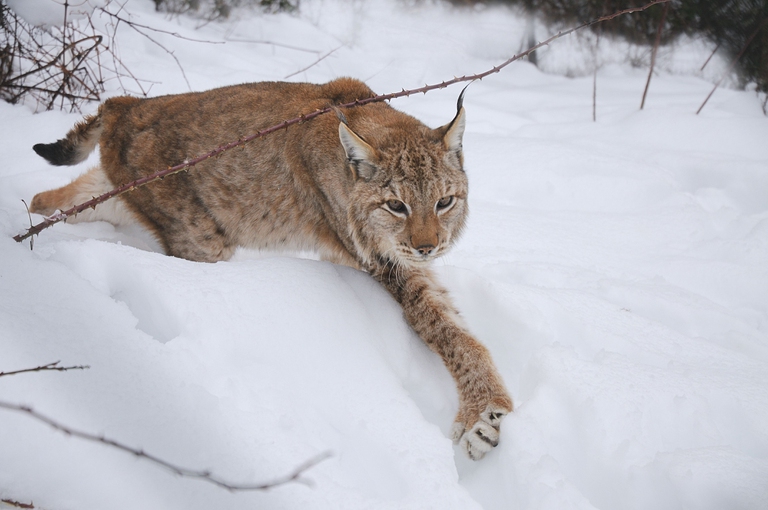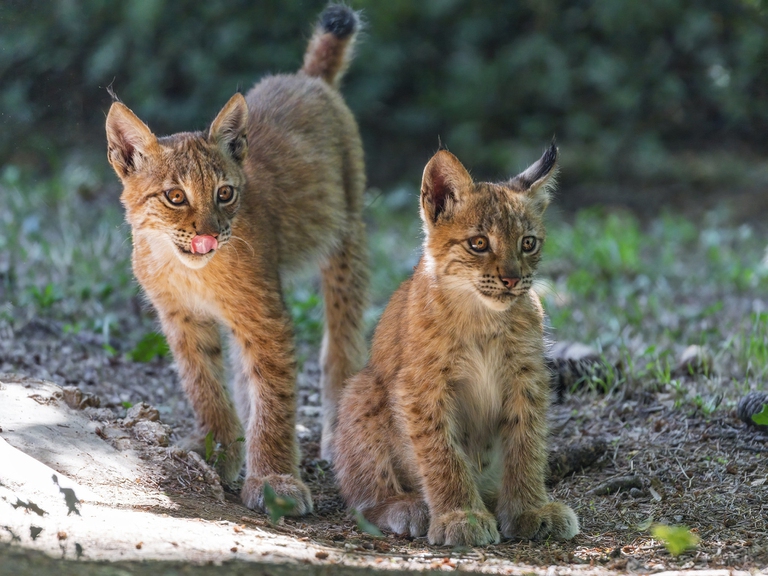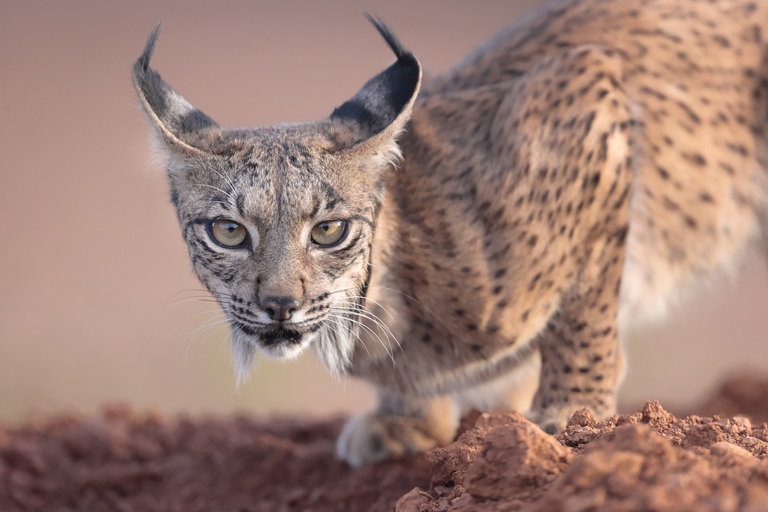- |
Excellent eyesight, exquisite hearing and incredible agility are just some of the extraordinary characteristics of the third largest predator in Europe and the rarest mammal present in Italy.We're talking about the Eurasian lynx.Once present throughout the Alpine arc, towards the end of the nineteenth century and the beginning of the twentieth, hunting and habitat loss they made this splendid feline disappear from our country.After the first reintroductions in the seventies, today, the remaining sedentary individuals (mainly in the eastern Alps) can be counted on the fingers of one hand, with an estimated population of around 150 individuals wandering between the Swiss and French borders.In the meantime, several projects are underway prevent a second extinction from occurring.
Let's discover the characteristics and history of this splendid animal.
The physical characteristics of the lynx
The Eurasian lynx (Lynx lynx) is the largest feline in Europe.They are present in the world 3 other species of lynx:the Iberian lynx (Lynx pardinus) present only in the Iberian peninsula, the Canadian lynx (Lynx canadensis) present particularly in Canada and Alaska, and the bobcat (Lynx rufus) also called bobcat, widespread throughout North America from Canada to Mexico.Of the four species of lynx the Eurasian one has the largest build, reaches a length of 80 to 120 cm, an average weight varying between males and females of around 20-30 kg for males and 18-20 for females.It has a stubby tail about 20 cm long.Its thick coat, depending on the season, varies from gray winter tones to reddish summer tones.It has both a camouflage and thermal function, in fact it is soft and thin in summer, long and thick in winter. The spots on the fur are a distinctive sign, each individual has different spots thanks to which researchers are able to distinguish each individual specimen.Two other easily recognizable characteristics are the black tufts present on the auricles and the thick "beard" of white hair under the muzzle.The long limbs and wide paws make it easier to move on the snow (as if they were snowshoes), furthermore, the fur-covered fingertips ensure that its movements are very silent.

Habitat and distribution
The Eurasian lynx is an expanding species from central Europe to the easternmost areas of Asia.In this vast territory it occupies various environments, from forests to rocky environments, from sea level to over 5 thousand meters above sea level.Moving from the Mediterranean climate to the temperate to the boreal.From Scandinavia to Russia it is the feline with the widest distribution in the world, however, in Europe we currently only find around 8-9 thousand individuals divided into 11 populations:the largest are found in northern Europe, while in central-western and southern Europe populations are isolated and fragmenting, for example in Italy the few specimens present are found in Friuli Venezia Giulia and Trentino.Its favorite habitat is undoubtedly the mountainous forest one, mainly due to its elusive nature, therefore to be able to hide and hunt by ambush, but also for the presence of prey such as ungulates and small mammals.
The behavior of the lynx
A solitary animal
The lynx is a mammal solitary and territorial.Males and females occupy separate areas and meet only during the mating period.Males have a much larger area than females, we are talking about around 250-300 square kilometers for males versus 50-100 for females.Being very territorial, individuals mark the boundaries of their territories so as to signal their presence to others and not clash, losing unnecessary energy.Parental care is the responsibility of the female who passes approx a year to look after her litter, generally made up of one to four puppies, which he teaches to hunt until they are emancipated.

A predator on the prowl
The lynx is an exceptional predator that he bases his hunt on ambush.The physical conformation and its peculiar characteristics make it a perfect predator.It is equipped with highly developed hearing and sense of smell which allow it to identify prey even in conditions of poor visibility.It is active throughout the day but its favorite moments are at dusk and dawn, in conjunction with the activity of its prey.In addition to its developed senses, it also has sharp teeth designed for cutting flesh, retractable claws that allow it to grasp prey with precision, and powerful muscle mass. Stealth is the key to the success of an attack, also exploiting the shape of the surrounding environment, manages to make long and sudden leaps on its prey, immobilizing it.Like most felines, it kills its prey by suffocating it with a bite to the throat.They are usually present on his menu small mammals such as rabbits, hares and foxes, always preferring to hunt ungulates, such as roe deer and chamois.
The relationship with man
A complicated relationship
The relationship between man and lynx has been the subject of a long and complex interaction.In many cultures the lynx was seen as a symbol of mystery and cunning.Its elusive nature and solitary behavior have inspired legends and myths in several traditions.For example, in Greek mythology the lynx was associated with the goddess Artemis, divinity of the hunt;or, in Native American cultures it was considered as totemic animal, symbol of wisdom and clear vision.However, the expansion of human activities has contributed to generating conflicts between the two species.The lynx was hunted for its precious and magnificent fur, but above all it was actively persecuted because it was considered harmful.Within a hundred years the lynx was completely eradicated.Hunters have never had any sympathy for this animal, seeing it as a strong competitor, as have breeders, who on the contrary saw it as a terrible danger for livestock.An antipathy towards the lynx of which we still see the effects today, for example in France, according to the most recent population estimates and if adequate conservation measures are not put in place, its population of 120-150 individuals only has thirty years left before disappearing forever.
Conservation works
Thanks to the first conservation and reintroduction projects in the early seventies, the lynx made its return first to Switzerland (1971), then to Slovenia (1973) and subsequently to Austria (1975).Initially the population, despite ups and downs, grew and prospered, but due to unregulated hunting, poaching and mainly poor genetic diversity the population began to drastically decline again.For this reason starting from 2000 increased efforts to conserve this species.In 2014, Italy also began to collaborate for the protection of the lynx, and this was how it started the first major Ulyca project (Urgent lynx conservation action) with which two individuals from the Swiss population were released in Friuli Venezia Giulia.A few years later, in 2017, it was launched the European Life lynx project with the aim of preventing the extinction of the lynx from the Dinaric mountains and the south-eastern Alps.Italy has never held back and thanks to the contribution of the forestry carabinieri, the Friuli region and the “lynx Italy” project decided to launch the second phase of the Ulyca project, so at the beginning of 2022 the Ulyca2 project was born, perfectly integrated and coordinated with the European Life lynx project. With the project at the beginning of this year in the Tarvisio forest, in Friuli, Five individuals from Switzerland, Romania and Croatia were released with the aim of strengthening both numerically but above all genetically the small Italian nucleus.The strategic position of the Tarvisio forest will have the aim of connecting all the sub-populations scattered across Europe by providing genetic variability and gene exchange.
Threats to the lynx
As we understand, there are two main threats to this splendid feline man and genetics.Man first and foremost unregulated hunting and with poaching it directly decreases the number of individuals in the area, both because they are killed and because they no longer find game to hunt.Another important human factor to take into consideration are road accidents, so much so that in France among the proposed interventions there is also updating road signs to avoid unpleasant accidents.The second threat as mentioned is genetics.In a population composed of a few individuals it increases considerably the risk of inbreeding, or mating between blood relatives, which affects reproductive success.A genetically weak population has a low ability to adapt to environmental changes, so it may not be able to adapt and survive possible changes in the scenario.For this reason genetic diversity is critical for survival and the good health of a population.
How is it faring in other parts of Europe
One of the greatest conservation works is undoubtedly that of Iberian lynx, the closest relative of the Eurasian lynx. The Iberian lynx population has continued to grow over the last few years, but she didn't do it alone.The reintroduction and conservation works of the species began in the early 2000s and meant that from a miserable population of 94 individuals, today there are many more than a thousand with as many as 240 females of reproductive age.Numbers not yet sufficient to declare the species out of danger but encouraging, especially for the other ongoing projects.One of these, difficult but not impossible, is what they have in mind in the Scottish Highlands, that is to say return the European lynx to their lands, disappeared since more than a thousand years. British rewilding it is known and has borne fruit, but now scientists must be able to convince the human population that it does not yet feel ready for the return of the feline.

Where to observe lynx in the wild
Being able to observe the lynx in its natural habitat it's very complicated, especially if you stay within our borders.In Northern Europe, in particular Norway, Sweden and Finland the possibilities could increase with their populations of around two thousand individuals.Staying closer to our borders you might think about a trip to the Carpathians, between the Czech Republic and Romania.Instead by moving in Andalusia, you may be lucky enough to meet the Iberian lynx.Surely the help of some expert guides will be essential to find it, but I repeat that it still remains a very complicated undertaking.However, you may come across the his traces left on the ground:its footprint has a width and length between 5.5 and 9 cm with a diameter of approximately 7-8 cm.The distance between the footprints per step is 80-100 cm.Although it may mislead you, since both overlap the trace of the hind legs with the front ones, do not confuse it with that of a wolf.Furthermore, the footprints are different, for example the paws of the felid do not have the nails that those of the canid have, and are more oval instead of rounded.
Lynx sighted in the Gran Paradiso National Park
In the first days of October, a lynx was captured by the lens of a camera trap within the borders of the Gran Paradiso National Park, in the Turin area.The presence of this dispersing individual made the park managers very happy since 1916 they had never sighted one again, with certainty.“A ghost of woods and rocks that we have been chasing for a long time” is how he defined it Bruno Bassano, director of the Park, announcing the sighting, then continues:“an often forgotten iconic species, but historically the only carnivore present on the Gran Paradiso massif”.This report opens the doors to the possibility, and the hope, of being able review the settlement of at least one couple in the future breeding in the park.
Symbol of cunning and elusiveness, she was unable to overcome human wickedness.Although its global population it is not at risk of extinction, in much smaller areas (such as ours) its population risks disappearing forever, and with it all the ecological benefits that the presence of a predator brings to the ecosystem.The word lynx it has an ancient derivation and means clear-luminous and also refers to one's ability to see in the dark.What we must hope is that its bright and brilliant eyes will shine again within the wooded areas of our Alps, so that we can boast of having brought this splendid animal back to our territory.
Concluding the journey to discover the lynx, all I can do is wish you good luck with your sightings!
